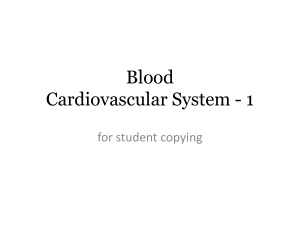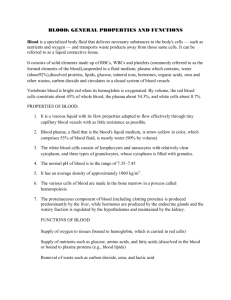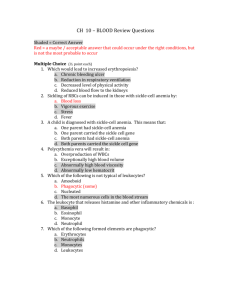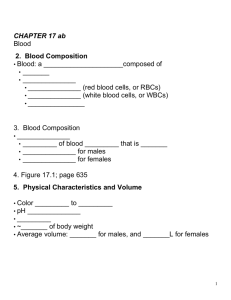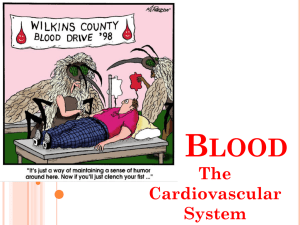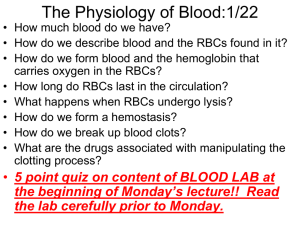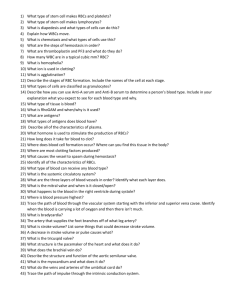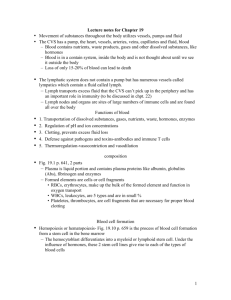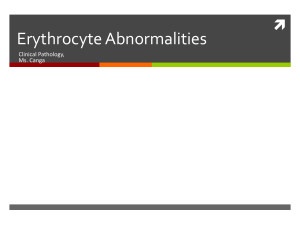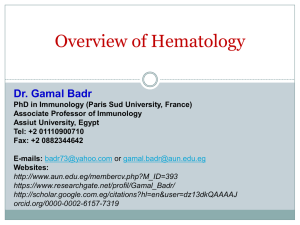Chapter 17 Blood
advertisement
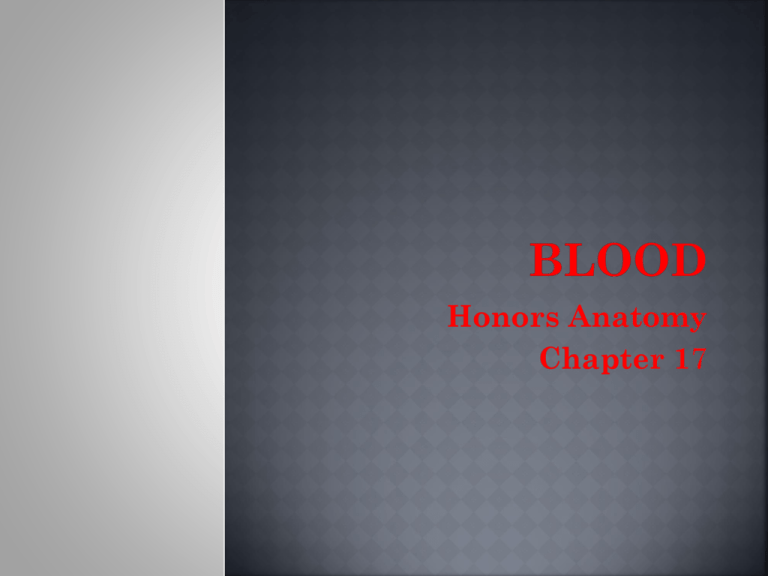
Honors Anatomy Chapter 17 is a type of CT made up of scattered cells & a liquid matrix well oxygenated- scarlet poorly oxygenated – dark red 1. Cells (45%) 2. RBCs WBCs Platelets (plts) Plasma (55%) water, a.a., proteins, carbohydrates, lipids, vitamins, hormones, electrolytes, cellular waste vol of blood cells in a sample of blood blood centrifuged then % cells figured normal levels: Newborns: 55-68% 10 yr olds: 36-40% Women: 38-46% Men: 42-54% transports substances maintains homeostasis in the body regulates body temperature maintains normal pH in body tissues maintains adequate fluid vol. protects against blood loss (hemostasis) prevents infection (abys, WBCs) hemophobia: fear of blood hemostasis: bleeding is under control hematocyte: blood cell hematemesis: vomiting blood hematuria: bloody urine hematopoiesis: formation of blood cells ~90% water Functions: transport nutrients, gases, vitamins, hormones maintain fluid & electrolyte balance maintains normal pH 1. Albumins 2. Globulins 3. made in liver/ 60% of plasma proteins maintain osmotic pressure & blood vol. α & β, from liver transport lipids & fat-soluble vitamins Fibrinogen from liver, largest of plasma proteins in blood clotting fibrin erythrocytes, formed in bone marrow shape: hematocytes, corpuscles biconcave disc allows for optimal surface area for diffusion of O2 & CO2 5 million/mm3 no nucleus so no cell division live about 120 days (no nucleus, mitochondria) then phagocytosed in liver & spleen 1. transport O2 thru out body (lungs cells) 2. hemoglobin: (hgb) large protein that O2 attaches to inside RBC transports CO2 (~20%) thru out body (cells lungs) oxyhemoglobin: plenty of oxygen being carried in RBCs, blood is bright red deoxyhemoglobin: not carrying much oxygen, blood is burgundy-red critical element needed to make hgb & normal RBCs most of body’s Fe is in RBCs in heme portion formation of blood cells in red bone marrow RBCs cells arise from hematopoietic stem ~15 days from stem cell to reticulocyte enter blood stream transporting oxygen ~2 more days mature RBC 1 – 2% of all erythrocytes count gives indication of rate of blood cell formation RBCs lifespan 100 – 120 days cannot make new proteins or organelles (no nucleus) become rigid, fragile block smaller vessels spleen filters out damaged RBCs engulfed by macrophages “lacking blood” condition in which O2 carrying capacity is too low to support normal metabolism it‘s a sign of some disorder not a disease 3 basic causes: 1. Blood loss 2. RBC production low 3. RBC destruction more than normal Hemorrhagic Anemia Acute 1. rapid, heavy tx‘d with blood transfusions Chronic 2. slight, persistent blood loss example: GI bleed, menorrhagia tx‘d by treating underying cause Fe-deficiency Anemia 1. often 2° to hemorrhagic anemia or from lo Fe consumption in diet RBCs small: microcytic, pale tx‘d: Fe supplements or increase in diet Pernicious Anemia 2. autoimmune disease elderly’s stomach mucosa cells that release intrinsic factor damaged less absorption of Vit B12 in intestines RBCs macrocytic, grow but cannot divide tx‘d: B12 shots Microcytic RBCs Macrocytic RBCs most cases, cause unknown Hallmark: marrow destruction all blood cells depleted: see clotting defects, immunity impaired tx‘d: stopgap: transfusions stem cells/ bone marrow transplant Thalassemias 1. Mediterreanean descent, many subtypes 1 of globin chains absent or faulty mild severe cases tx‘d: monthly transfusions Sickle Cell 2. Β chains have 1 abnormal amino acid RBCs sickle in conditions of lo O2 block small blood vessels lo O2 delivery causes pain, SOB tx‘d: transfusions/ O2 new: inhale nitric oxide dilates leukocytes general function: defend the body against pathogens Type Name Function Granulocytes Neutrophils aka PMNs polymorphoneutrophils very active in phagocyting bacteria & are present in large #s in pus of wounds, most common of all types, normal= 60% of WBCs Eosinophils attack parasites, control allergic reactions 2% of WBC count (granular cytoplasm) Picture type Name Function Granulocytes continued Basophils produces heparin (prevents blood clots) & histamines (inflammatory reaction) 1% of WBC Agranulaocytes (lacking granular cytoplasm) Monocytes precursors of macrophages; 6% of WBC Lymphocytes main cell of immune system 30% of WBC Picture thrombocytes cell fragments formed from megakaryocyte, live ~4 days help initiate formation of blood clots release clotting factors glycoproteins on plasma membranes of RBCs act as antigens (agns):anythin that induces immune response RBCs from different blood type will agglutinate (clump) ABO & Rh blood groups cause vigorous transfusion reactions if not properly matched ~85% of Americans Rh+ antibodies not spontaneously in human blood


